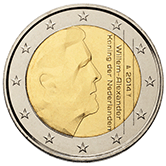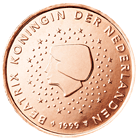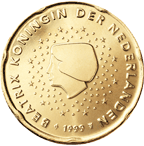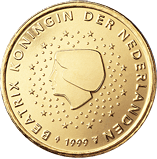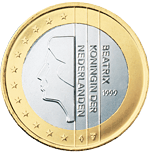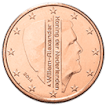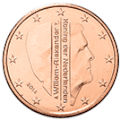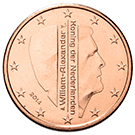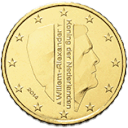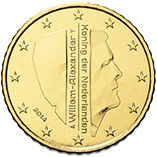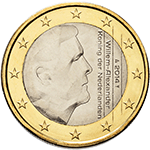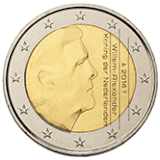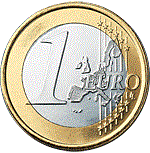
There are eight euro coin denominations, ranging from one cent to two euros. The coins first came into use in 2002. They have a common reverse, portraying a map of Europe, but each country in the eurozone has its own design on the obverse, which means that each coin has a variety of different designs in circulation at once. Four European microstates that are not members of the European Union use the euro as their currency and also have the right to mint coins with their own designs on the obverse side.
Belgian euro coins feature only a single design for all eight coins: the portrait or effigy of the King of the Belgians. Previously, all Belgian euros depicted King Albert II and his royal monogram. Current coins depict King Philippe. Also part of the design by Jan Alfons Keustermans are the 12 stars of the EU and the year of imprint.
Spanish euro coins feature three different designs for each of the three series of coins. The minor series of 1, 2, and 5 cent coins were designed by Garcilaso Rollán, the middle series of 10, 20, and 50 cent coins by Begoña Castellanos, and the two major coins feature the portrait of King Felipe VI of Spain. All designs feature the 12 stars of the EU, the year of minting, and the word España.
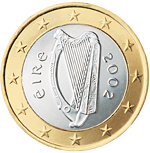
Irish euro coins all share the same design by Jarlath Hayes, that of the harp, a traditional symbol for Ireland since the Middle Ages, based on that of the Brian Boru harp, housed in Trinity College Dublin. The same harp is used as on the official seals of the Taoiseach, and government ministers and the seal of the president of Ireland. The coins' design also features the 12 stars of the EU, the year of issue and the Irish name for Ireland, "Éire", in a traditional Gaelic script.
Finnish euro coins feature three designs. Heikki Häiväoja provided the design for the 1 cent – 50 cent coins, Pertti Mäkinen provided the design for the 1 euro coin, and Raimo Heino provided the design for the 2 euro coin, which shows cloudberry, the golden berry of northern Finland. All designs feature the 12 stars of the EU and the year of imprint.

The British one pound (£1) coin is a denomination of sterling coinage. Its obverse bears the Latin engraving ELIZABETH II D G REG F D meaning, 'Elizabeth II, by the grace of God, Queen, Defender of the Faith'. It has featured the profile of Queen Elizabeth II since the original coin's introduction on 21 April 1983. Four different portraits of the Queen have been used, with the latest design by Jody Clark being introduced in 2015. The design on the reverse side of the current, 12-sided coin features four emblems to represent each of the nations of the United Kingdom — the English rose, the leek for Wales, the Scottish thistle, and the shamrock for Northern Ireland, also two or three oak leaves — emerging from a single 5-branched stem within a crown. In May 2022 the Royal Mint announced that the Kenyan-born artist Michael Armitage is designing a new £1 coin which will be issued in 2023 and will celebrate the "history of the UK in the 21st century".
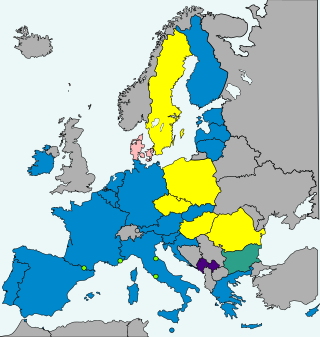
Vatican euro coins are issued by the Philatelic and Numismatic Office of the Vatican City State and minted by Istituto Poligrafico e Zecca dello Stato (IPZS), in Rome, Italy. The euro is the official currency of the Vatican City, although Vatican City is not a member of the Eurozone or the European Union. The euro has been the official currency of Vatican City since 2002. Before that, the Vatican lira was the official currency.
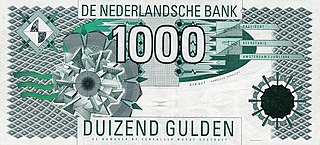
The guilder or florin was the currency of the Netherlands from 1434 until 2002, when it was replaced by the euro.

The rijksdaalder was a Dutch coin first issued by the Republic of the Seven United Netherlands in the late 16th century during the Dutch Revolt which featured an armored half bust of William the Silent. It was the Dutch counterpart of the Reichsthaler of the Holy Roman Empire but weighed slightly less, at 29.03 g of 0.885 fine silver, reduced to 0.875 fine by the 17th century. Friesland, Gelderland, Holland, Kampen, Overijssel, Utrecht, West Friesland, Zeeland, and Zwolle minted armored half bust rijksdaalders until the end of the 17th century.
The florin or Aruban guilder is the currency of Aruba. It is subdivided into 100 cents. The florin was introduced in 1986, replacing the Netherlands Antillean guilder at par. The Aruba currency exchange rate for U.S. dollars is Afl 1.77 for cash and Afl 1.78 for traveller's checks. Most supermarkets and gas stations use the exchange rate of Afl 1.75, while many restaurants and shops use the exchange rate of Afl 1.80.

The 1 euro cent coin (€0.01) has a value of one hundredth of a euro and is composed of copper-covered steel. It is the lowest-value coin in the Eurozone; the next highest are the 2 and 5 euro cent coins. All euro coins have a common reverse and a country-specific (national) obverse. The coin has been used since 2002 and was not redesigned in 2007 as was the case with the higher-value coins.

The 2 euro cent coin (€0.02) has a value of one-fiftieth of a euro and is composed of copper-plated steel. All euro coins have a common reverse and country-specific (national) obverse. The coin has been used since 2002 and was not redesigned in 2007 as were the higher-value coins.

The 5 euro cent coin (€0.05) has a value of one twentieth of a euro and is composed of copper-covered steel. All euro coins have a common reverse and country-specific (national) obverse. The coin has been used since 2002 and was not re-designed in 2007 as was the case with the higher-value coins.

The 10 euro cent coin (€0.10) has a value of one tenth of a euro and is composed of an alloy called Nordic gold. All euro coins have a common reverse side and country-specific national sides. The coin has been used since 2002, with the present common side design dating from 2007.

The 20 euro cent coin (€0.20) has a value of one-fifth of a euro and is composed of an alloy called Nordic Gold in the Spanish flower shape. All euro coins have a common reverse side and country-specific national sides. The coin has been used since 2002, with the present common side design dating from 2007.

The Dutch Five guilder coin was the highest-denomination coin in the Netherlands from its introduction in 1988 until the adoption of the euro in 2002. Its nominal value was ƒ 5,-.
The One guilder coin was a coin struck in the Kingdom of the Netherlands between 1818 and 2001. It remained in circulation until 2002 when the guilder currency was replaced by the euro. No guilder coins were minted in the German occupation of the Netherlands in World War II.
Before the introduction of the euro, the current eurozone members issued their own individual national coinage, most of which featured mint marks, privy marks and/or mint master marks. These marks have been continued as a part of the national designs of the euro coins, as well. This article serves to list the information about the various types of identifying marks on euro coins, including engraver and designer initials and the unique edge inscriptions found on the €2 coins.
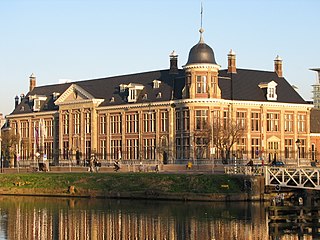
The Royal Dutch Mint based in Utrecht, the Netherlands, is a company owned by Heylen Group. It was established and previously owned by the Dutch state.

Andorra has a monetary agreement with the EU allowing it to make the euro its official currency, and permitting it to issue euro coins from 1 July 2013. They planned to issue their first coins by March or April 2014. On 23 December 2014, coins were delivered for pre-booked customers at the Government Administration Building, and actual circulation began on 15 January 2015.
